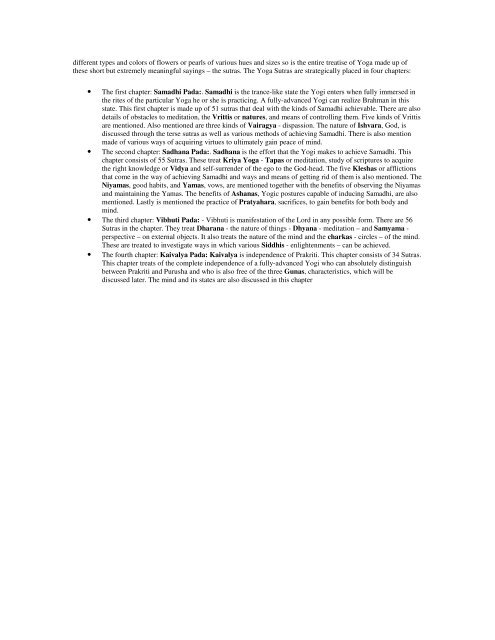You also want an ePaper? Increase the reach of your titles
YUMPU automatically turns print PDFs into web optimized ePapers that Google loves.
different types and colors of flowers or pearls of various hues and sizes so is the entire treatise of Yoga made up of<br />
these short but extremely meaningful sayings – the sutras. The Yoga Sutras are strategically placed in four chapters:<br />
• The first chapter: Samadhi Pada:. Samadhi is the trance-like state the Yogi enters when fully immersed in<br />
the rites of the particular Yoga he or she is practicing. A fully-advanced Yogi can realize Brahman in this<br />
state. This first chapter is made up of 51 sutras that deal with the kinds of Samadhi achievable. There are also<br />
details of obstacles to meditation, the Vrittis or natures, and means of controlling them. Five kinds of Vrittis<br />
are mentioned. Also mentioned are three kinds of Vairagya - dispassion. The nature of Ishvara, God, is<br />
discussed through the terse sutras as well as various methods of achieving Samadhi. There is also mention<br />
made of various ways of acquiring virtues to ultimately gain peace of mind.<br />
• The second chapter: Sadhana Pada:. Sadhana is the effort that the Yogi makes to achieve Samadhi. This<br />
chapter consists of 55 Sutras. These treat Kriya Yoga - Tapas or meditation, study of scriptures to acquire<br />
the right knowledge or Vidya and self-surrender of the ego to the God-head. The five Kleshas or afflictions<br />
that come in the way of achieving Samadhi and ways and means of getting rid of them is also mentioned. The<br />
Niyamas, good habits, and Yamas, vows, are mentioned together with the benefits of observing the Niyamas<br />
and maintaining the Yamas. The benefits of Ashanas, Yogic postures capable of inducing Samadhi, are also<br />
mentioned. Lastly is mentioned the practice of Pratyahara, sacrifices, to gain benefits for both body and<br />
mind.<br />
• The third chapter: Vibhuti Pada: - Vibhuti is manifestation of the Lord in any possible form. There are 56<br />
Sutras in the chapter. They treat Dharana - the nature of things - Dhyana - meditation – and Samyama -<br />
perspective – on external objects. It also treats the nature of the mind and the charkas - circles – of the mind.<br />
These are treated to investigate ways in which various Siddhis - enlightenments – can be achieved.<br />
• The fourth chapter: Kaivalya Pada: Kaivalya is independence of Prakriti. This chapter consists of 34 Sutras.<br />
This chapter treats of the complete independence of a fully-advanced Yogi who can absolutely distinguish<br />
between Prakriti and Purusha and who is also free of the three Gunas, characteristics, which will be<br />
discussed later. The mind and its states are also discussed in this chapter
















